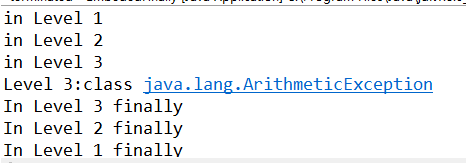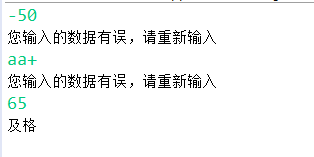一、.异常处理基础
测试代码一:
1 import javax.swing.*; 2 3 class AboutException { 4 public static void main(String[] a) 5 { 6 int i=1, j=0, k; 7 k=i/j; 8 9 10 try 11 { 12 13 k = i/j; // Causes division-by-zero exception 14 //throw new Exception("Hello.Exception!"); 15 } 16 17 catch ( ArithmeticException e) 18 { 19 System.out.println("被0除. "+ e.getMessage()); 20 } 21 22 catch (Exception e) 23 { 24 if (e instanceof ArithmeticException) 25 System.out.println("被0除"); 26 else 27 { 28 System.out.println(e.getMessage()); 29 30 } 31 } 32 33 34 finally 35 { 36 JOptionPane.showConfirmDialog(null,"OK"); 37 } 38 39 } 40 }
运行结果截图:

因执行 i/j 零作为除数而抛出异常
测试代码二(使用JAVA异常处理机制):
1 import javax.swing.*; 2 3 class AboutException { 4 public static void main(String[] a) 5 { 6 int i=1, j=0, k; 7 //k=i/j; 8 9 10 try 11 { 12 13 k = i/j; // Causes division-by-zero exception 14 //throw new Exception("Hello.Exception!"); 15 } 16 17 catch ( ArithmeticException e) 18 { 19 System.out.println("被0除. "+ e.getMessage()); 20 } 21 22 catch (Exception e) 23 { 24 if (e instanceof ArithmeticException) 25 System.out.println("被0除"); 26 else 27 { 28 System.out.println(e.getMessage()); 29 30 } 31 } 32 33 34 finally 35 { 36 JOptionPane.showConfirmDialog(null,"OK"); 37 } 38 39 } 40 }
执行结果:

JAVA异常处理:
1.捕获语句:
Try{
//可能发生运行错误的代码;
}
catch(异常类型 异常对象引用){
//用于处理异常的代码
}
finally{
//用于“善后” 的代码
}
2.异常处理机制:
- 把可能会发生错误的代码放进try语句块中。
- 当程序检测到出现了一个错误时会抛出一个异常对象。异常处理代码会捕获并处理这个错误。
- catch语句块中的代码用于处理错误。
- 当异常发生时,程序控制流程由try语句块跳转到catch语句块。
- 不管是否有异常发生,finally语句块中的语句始终保证被执行。
- 如果没有提供合适的异常处理代码,JVM将会结束掉整个应用程序。
二、多层异常捕获:
测试代码一:
1 public class CatchWho { 2 public static void main(String[] args) { 3 try { 4 try { 5 throw new ArrayIndexOutOfBoundsException(); 6 } 7 catch(ArrayIndexOutOfBoundsException e) { 8 System.out.println( "ArrayIndexOutOfBoundsException" + "/内层try-catch"); 9 } 10 11 throw new ArithmeticException(); 12 } 13 catch(ArithmeticException e) { 14 System.out.println("发生ArithmeticException"); 15 } 16 catch(ArrayIndexOutOfBoundsException e) { 17 System.out.println( "ArrayIndexOutOfBoundsException" + "/外层try-catch"); 18 } 19 } 20 }
执行结果:

测试代码二:
1 public class CatchWho2 { 2 public static void main(String[] args) { 3 try { 4 try { 5 throw new ArrayIndexOutOfBoundsException(); 6 } 7 catch(ArithmeticException e) { 8 System.out.println( "ArrayIndexOutOfBoundsException" + "/内层try-catch"); 9 } 10 throw new ArithmeticException(); 11 } 12 catch(ArithmeticException e) { 13 System.out.println("发生ArithmeticException"); 14 } 15 catch(ArrayIndexOutOfBoundsException e) { 16 System.out.println( "ArrayIndexOutOfBoundsException" + "/外层try-catch"); 17 } 18 } 19 }
执行结果:

原因分析:
JAVA异常处理流程:
(1)如果程序中产生了异常,那么JVM根据异常的类型,实例化一个指定异常类的对象;
(2)如果这时程序中没有任何的异常处理操作,则这个异常类的实例化对象将交给JVM进行处理,而JVM的默认处理方式就是进行异常信息的输出,而后中断程序执行;
(3)如果程序中存在了异常处理,则会由try语句捕获产生的异常类对象;
(4)与try之后的每一个catch进行匹配,如果匹配成功,则使用指定的catch进行处理,如果没有匹配成功,则向后面的catch继续匹配,如果没有任何的catch匹配成功,则这个时候将交给JVM执行默认处理;
(5)不管是否有异常都会执行finally程序,如果此时没有异常,执行完finally,则会继续执行程序之中的其他代码,如果此时有异常没有能够处理(没有一个catch可以满足),那么也会执行finally,但是执行完finally之后,将默认交给JVM进行异常的信息输出,并且程序中断。
(参考:http://blog.csdn.net/wei_zhi/article/details/52836838)
三、finally执行时机:
测试代码:
1 public class EmbededFinally { 2 3 4 public static void main(String args[]) { 5 6 int result; 7 8 try { 9 10 System.out.println("in Level 1"); 11 12 13 try { 14 15 System.out.println("in Level 2"); 16 // result=100/0; //Level 2 17 18 try { 19 20 System.out.println("in Level 3"); 21 22 result=100/0; //Level 3 23 24 } 25 26 catch (Exception e) { 27 28 System.out.println("Level 3:" + e.getClass().toString()); 29 30 } 31 32 33 finally { 34 35 System.out.println("In Level 3 finally"); 36 37 } 38 39 40 // result=100/0; //Level 2 41 42 43 } 44 45 catch (Exception e) { 46 47 System.out.println("Level 2:" + e.getClass().toString()); 48 49 } 50 finally { 51 52 System.out.println("In Level 2 finally"); 53 54 } 55 56 // result = 100 / 0; //level 1 57 58 } 59 60 catch (Exception e) { 61 62 System.out.println("Level 1:" + e.getClass().toString()); 63 64 } 65 66 finally { 67 68 System.out.println("In Level 1 finally"); 69 70 } 71 72 } 73 74 }
执行结果:

结论:
finally 代码块出现在 catch 代码块最后,用来创建在 try 代码块后面执行的代码块。
无论是否发生异常,finally 代码块中的代码总会被执行。
四、finally探讨:
测试代码:
1 public class SystemExitAndFinally { 2 3 4 public static void main(String[] args) 5 { 6 7 try{ 8 9 10 System.out.println("in main"); 11 12 throw new Exception("Exception is thrown in main"); 13 14 //System.exit(0); 15 16 17 } 18 19 catch(Exception e) 20 21 { 22 23 System.out.println(e.getMessage()); 24 25 System.exit(0); 26 27 } 28 29 finally 30 31 { 32 33 System.out.println("in finally"); 34 35 } 36 37 } 38 39 40 }
执行结果:

结论:
当程序在finally代码块之前结束时,因程序退出,finally内的语句将不再执行。
五、课程成绩:
程序代码:
1 import java.util.Scanner; 2 3 public class Grade { 4 public static void main(String[] args) { 5 // TODO Auto-generated method stub 6 double score = 0; 7 String G; 8 while(true) { 9 Scanner in = new Scanner(System.in); 10 try { 11 score = in.nextDouble(); 12 int s = (int)score; 13 s = s / 10; 14 switch(s) { 15 case 10: 16 case 9:G = "优";break; 17 case 8:G = "良";break; 18 case 7:G = "中";break; 19 case 6:G = "及格";break; 20 case 5: 21 case 4: 22 case 3: 23 case 2: 24 case 1: 25 case 0:G = "不及格";break; 26 default:throw new Exception(); 27 } 28 System.out.println(G); 29 break; 30 }catch(Exception e) { 31 System.out.println("您输入的数据有误,请重新输入"); 32 } 33 } 34 } 35 }
执行结果:
